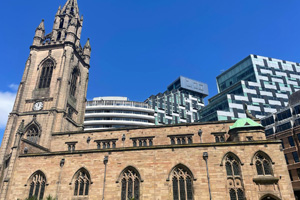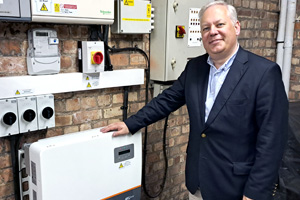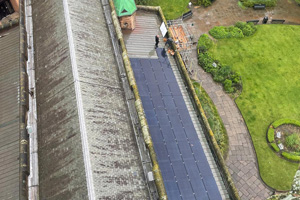 Liverpool Parish Church is the first in our diocese to have solar panels fitted to the roof of their traditional main building, at Our Lady and St Nicholas in the heart of Liverpool city centre.
Liverpool Parish Church is the first in our diocese to have solar panels fitted to the roof of their traditional main building, at Our Lady and St Nicholas in the heart of Liverpool city centre.
The Grade II listed church, which sits in a protected conservation area, has had 56 solar (or photovoltaic: pv) panels fitted to its roof, as part of efforts to reach net zero carbon by 2030.
It’s expected to cut the church’s demand on the electricity grid, and therefore reduce their electricity bills, by around 80% in the height of summer, and around 50% annually.
A Bronze Eco Church, St Nick’s is among a growing number of churches who have committed to our Diocese of Liverpool’s Net Zero Carbon 2030 Programme, and embarked on a feasibility study to explore future options to further reduce their carbon footprint.
The switch to install a renewable energy source is an important step in that journey, by reducing reliance on fossil fuels.
Please read below for a Q&A with Revd Canon Dr Crispin Pailing MBE, former Rector of Liverpool, and St Nick’s Building Manager and Eco Champion Stephen Derringer, about the project.
Welcoming the development, Phil Leigh, Diocesan Environmental Officer and NZC2030 Programme Lead said: “It’s hugely significant that we’ve got a church now with solar panels on the roof of their traditional main building.
“As we journey together to net zero carbon we are grateful to Liverpool Parish Church for their leadership in this, and providing an example for other churches to come and see.”
He added: “If any church is considering solar as an option, our Net Zero Carbon 2030 Programme team have lots of insights and expertise we can share, and we’re regularly updated about funding opportunities too, so do get in touch to find out more.”
Stephen, Building Manager and Eco Champion at St Nick’s, said: “We hope our solar project is a beacon for other churches to follow suit, we’re very proud of what we’ve achieved and we’re keen to share the work with others across the diocese.”
“I do encourage all churches to seriously look at what needs to be done towards net zero carbon, as every small step is progress.”
Looking forwards, he said: “The next thing we want to do is to reduce our use of gas, because that’s our biggest energy expenditure at the moment, and has the biggest impact in terms of our overall carbon footprint.
“We’ve had an energy feasibility study conducted with Phil and the diocese’s Net Zero Carbon team. There are a few options to consider.
“In the meantime, we’ll be working on developing our net zero carbon plan, and continuing our work as an Eco church, to do all we can to help care for God’s creation.”
Stephen has offered for any church that wishes to find out more about the Liverpool Parish Church to get in touch. You can do this directly, or via the Diocese’s Net Zero Carbon 2030 Programme team: Contact phil.leigh@liverpool.anglican.org
Q - Why did the church decide to go down the solar panels route?
With a 41-tonne carbon footprint logged via the Energy Footprint Tool (EFT) for 2022, St Nick’s is among the highest energy users in our diocese, due to its high footfall and usage 365 days a year, at the heart of Liverpool’s visitor economy.
Father Pailing said: “As a church we are committed to net zero carbon and we are doing everything we can towards that.
“In our context we are a significant building in the visitor economy, so we are open all day every day, we’re very busy, we’ve got rooms that are hired out every day, and two residential flats in the building, so we are a high energy usage building.
“The precursor to this work was switching as many of our lights as we could to LEDs, we’ve done a lot in terms of smart use of out of our heating, so we’ve shrunk everything. We’ve had surveys done with Phil and the net zero carbon team about what else we can do, and this was the next step.”
Q - What are the benefits?
 A - On a sunny day the panels will generate 21 kilowatts of energy at any particular time, enough to run ten electric kettles, ten 3-bar electric fires, or 2,000 LED light bulbs.
A - On a sunny day the panels will generate 21 kilowatts of energy at any particular time, enough to run ten electric kettles, ten 3-bar electric fires, or 2,000 LED light bulbs.
Fr Pailing said: “In the height of summer this should reduce electricity bills by about 80% and over the course of 12 months it means around a 50% average reduction across the year.”
“So, in terms of finances, it reduces costs. In terms of the environment it’s a better thing, because everything that uses renewable energy rather than fossil fuels, is better.
“In terms of mission, the process in itself is about God’s creation, and our stewardship of it. I hope that every church is already on a net zero journey at some stage or another.
“Even if you are only replacing your bulbs with LEDs it’s a start, and after you’ve done that you’ve got to ask ‘What next?’, because this is a commitment made as a national church and it’s something we all believe in.”
Q - Have your local community engaged with the project?
A - Fr Pailing said: “In addition to finances and mission, it is about leadership in an area - there are other organisations in the city centre that have already spoken with me about whether their buildings could do it.”
The church has kept the congregation informed about the project with regular updates in the church newsletter. They are working on plans to further engage visitors and the local community with information about the benefits of switching to solar.
A digital screen will greet visitors on arrival informing them about the LED lighting and solar panels. A further display is planned offering live information about the amount of electricity being generated and consumed.
Q - What happens to any power generated that you don’t use?
A - Any power generated that the church doesn’t use will be sent back into the national grid, meaning the church may earn some income via a ‘feed in tariff’.
Stephen said: “The energy is used by the church during the day, and any spare electricity we generate that we don’t use is exported back to the grid.
“We don’t use a battery because the chance of using the power at night is very low, and the added expense of batteries, which would could cost upwards of £2000, so £6,000 for three batteries, is not value for money if you’re not using power at night.”
He added: “For other churches that aren’t open in the week, another benefit could be if you can put power back into the grid. They can be paid for the amount of energy they export and that can help offset the small amount of energy they use - if there is an option for a feed in tariff in their area.”
Q - How much did the project cost?
A - The church invested £26,000 in the solar project including around £10,000 grant funding and further grant applications are still outstanding.
It’s anticipated the system will have ‘paid back’ for itself within around 8 years, due to savings on energy bills. Other churches with lower energy demands may not need such a large system to achieve a similar rate of results in terms of energy savings and pay back.
Q - What was the process to achieve the installation?
 A - The journey began 18 months ago when the St Nick’s PCC passed a resolution in 2022 to press ahead with the solar plan. As the church is in a conservation area they needed to apply for local authority planning permission – though this is not always necessary for all solar installations.
A - The journey began 18 months ago when the St Nick’s PCC passed a resolution in 2022 to press ahead with the solar plan. As the church is in a conservation area they needed to apply for local authority planning permission – though this is not always necessary for all solar installations.
As a Grade II listed building the church also needed the agreement of the DAC (Diocesan Advisor Committee) and a faculty from the Chancellor.
The church commissioned a professional architect to assist with the design technicalities, and a professional town planner to prepare the planning application.
Fr Pailing said: “Because we were bombed in the war the place where the solar panels have gone in fact dates to 1952, so issues around the structural soundness of the roof were easily dealt with.
“The greater considerations were that it’s in a conservation area, which is an issue for the local authority, and it’s a Grade II listed building, which is an issue for the DAC and for the faculty process.”
The solar panels are not visible from ground level, and the planning application was quickly approved earlier this year (2024). The DAC faculty was also approved earlier this year, following detailed work to provide assurance the solar panels would be securely attached to the roof, without causing damage to the building.
Q – What has been installed, where and how?
A - Stephen said: “The roof has got to be south facing, and bearing in mind that most churches are built east to west, they are very likely to have a full south facing roof. The south facing roof in our case is the one that points towards the Liver building. On that roof, we have 56 solar pv panels. On a good day the panels will generate 21 kilowatts at any particular time.”
After researching several quotes, the church commissioned Darran Ford from solar panel specialists Simcott Renewables to complete the work, and the final installation took around three weeks.
Q - Any tips for other churches?
A - Fr Pailing said: “First of all, do it! Secondly, engage with your contractor in detail over concept as well as design and installation, because church buildings are unique, and so you do need someone who understands the challenge.
“If you’ve got a non-listed building in a residential area you probably don’t need planning permission, as it’s likely to be a ‘permitted development’.
“However, if you are listed, or are in a conservation area you may need planning permission. In terms of planning permission, get someone with professional expertise to do it. It is not like doing a domestic extension, it’s a professional job.
“Make sure that the congregation buys into it as their project as well. It’s important for mission and environment. We wanted to ensure that it was something that was owned by the whole church, not just the PCC. We have a relatively large congregation here, we gave them regular updates, we send a weekly e-bulletin which goes to about 400 people every week, so we sent photographs of the installation to them throughout so they were all seeing the progress.”
Q - What’s next?
A - Stephen said: “Because the roof was installed in 1952, it’s quite well insulated and quite advanced for its time.
“The next thing we want to do is to reduce our use of gas, because that’s our biggest energy expenditure at the moment, and has the biggest impact in terms of our overall carbon footprint.
“We’ve had an energy feasibility study conducted with Phil Leigh and the Diocese’s Net Zero Carbon team. There are a few options to consider, one being a ground source heat pump, but these very expensive, and another is we may be able to benefit from a Mersey Heat Network Energy Centre that’s being planned for the city centre.
“In the meantime, we’ll be working on developing our net zero carbon plan, and continuing our work as an Eco church, to do all we can to help care for God’s creation.”
He added: “We hope our solar project is a beacon for other churches to follow suit, we’re very proud of what we’ve achieved and we’re keen to share the work with others across the diocese.”
“I do encourage all churches to seriously look at what needs to be done towards net zero carbon, as every small step is progress.”